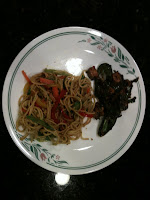
Yesterday was Ram Navami and I made the usual fare of
panagam and
neer more. I have posted the recipes for these previously
here. I also changed it up by making semiya payasam (kheer), puliyogare with homemade pulikachal and beans curry.

Tamarind rice is a very interesting dish to me and I have spent extensive time researching the nuances in the different versions. My love for it started from the tamarind rice given as prasadam in the temples in Hyd and during Ganesh Chaturti. It took me many years to replicate this version in my kitchen. It is called Pulihora in Andhra. This version is based purely on the flavor of tamarind and its sourness with some auxiliary things like chana dal giving added flavor. This tastes best a few hours after it has been made because rice then has enough time to soak in the tamarind's sourness. Puliyogare which is probably the kannada version uses some added spices which give it a darker color and enhances the flavor even more. I have not yet made this on my own. I use MTR's Puliyogare powder or paste and it turns our fine. This is a quick fix for a busy weekday night or when you have leftover rice. Pulikachal, which is the tamilian version, is mixed into rice to make Puli Chadam. What you see in the picture above is this. Pulikachal ends up being a thick tamarind pulp, reduces over a medium flame, with a spice powder added to it. My MIL's version also has kabuli chana which I usually add but for a change I added black chana. This definitely ups the protein content of the dish and give you something interesting to chew besides rice in this dish:). To help make the cooking process quick, I usually make the spice powder in bulk and freeze.
Pulihora Recipe: The beauty of this recipe is in its simplicity. You can add soaked and boiled black chana to this as well. Add anything more and you lose the authentic taste. I reached this conclusion after many trial and error recipes.
Ingredients:
- Rice - 2 cups
- Tamarind pulp - 1-1.5 cup (depends on how sour your tamarind is)
- Oil - 1 tbsp
- Green chillies - 3 or 4
- Dried red chillies - 4 or 5
- Urad dal - 1 tsp
- Chana dal - 2 tsp
- Groundnuts - 1 cup
- Turmeric - 1/2 tsp
- Salt
- Mustard seeds - 1 tsp
- Curry leaves - 8
Directions:
- Heat oil in a pan and add mustard seeds and turmeric to it.
- Once the mustard seeds have sputtered, add urad dal, chana dal, peanuts, green chillies, red chillies, curry leaves and roast these until urad dal and chana dal is golden brown. You may want to roast the peanuts separately and then add as they take longer.
- Add the rice, tamarind pulp and salt and mix well.
- Taste to check the sourness and add more tamarind pulp if needed.
- Place a lid and let the rice steam so that the rawness of tamarind goes away.
Puliyogare Recipe: I dont really have an authentic recipe for this one. My friend promised me one and hasn't given it to me yet (you know who you are :) ). I promise to blog once I have it. I use the MTR puliyogare powder. I make tadka with mustard, peanuts, red chillies and add the mix followed by rice.
Pulikachal Recipe: This recipe is split into 3 parts - recipe for the spice powder, recipe for the pulikachal and directions to make puli chadam.
Pulikachal spice powder recipe: This is an adaptation from my MIL's recipe with some changes.
Ingredients:
- Gingelly oil - 1 tsp
- Chana dal - 1 tbsp
- Mustard seeds - 1/2 tsp
- Jeera - 1 tsp
- Black sesame seeds - 1 tbsp
- Urad dal - 1 tbsp
- Methi seeds - 1/2 tsp
- Black pepper - 1 tbsp
- Red chillies - 5/6
- Coconut - grated, 1 cup
- Curry leaves - 5/6
Directions: Roast all the above ingredients individually in the oil and grind together to form a powder. The coconut should be roasted until it is golden brown. This can be made in bulk using cups for measurement instead of tsps as long as you keep the proportions.
Pulikachal Recipe: Pulikachal can used as a pickle or as a quick mix with rice to make puli chadam. It can be stored in an airtight jar in the fridge for a couple of weeks.
Ingredients:
- Tamarind pulp - 3 cups
- Water - 3 cups
- Gingelly oil - 1 tbsp
- Mustard seeds - 1 tsp
- Urad dal 1 tsp
- Black chana dal soaked and boiled or kabuli chana soaked and boiled - 1.5 cups
- Red chillies - 4/5
- Curry leaves - 8/10
- Hing - 1/4 tsp
- Salt
- Turmeric powder - 1/2 tsp
- Pulikachal spice powder - 4/5 tbsps
Directions:
- Heat oil in a pan and add mustard seeds, turmeric and hing. Once they sputter, add urad dal and roast till golden brown.
- Add red chillies and curry leaves and roast till you can smell their aroma.
- Add the black chana or kabuli chana and roast well for about 15 mins.
- Add the tamarind pulp, water and salt and boil this mixture until it reduces and becomes a thick pulp. This usually takes 30-45mins.
- Add the spice powder and mix well. Pulikachal is ready.
Directions to make puli chadam: Take a few teaspoons of the pulikachal and add it to 2 cups of rice. Add some gingelly oil and jump into the bowl with your hands like a true tamilian and mix away:). Serve this with papad and you have reached tamilian heaven:)
















